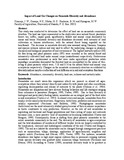| dc.description.abstract | This study was conducted to determine the effect of land use on nematode community
structure. The land use types represented in the study sites were natural forest, plantation
forest, tea, coffee, napier grass, agroforestry, fallow and annual crops dominated by
maize and beans. Nematode diversity and abundance decreased with intensity of land
cultivation or human interference, with the natural forest being regarded as the
benchmark. The decrease in nematode diversity was assessed using Shannon, Simpson
and species richness indices and was used to reflect the underlying changes in physical,
chemical and biological properties of soil environment. The highest maturity indices (MI)
for free-living and plant parasitic index (PPI) were recorded in the natural forest and
intensively cultivated land under annual crops (maize/beans) respectively. Herbivorous
nematodes were predominant in soils that were under agricultural production while
saprofagic nematodes dominated the forested land as exemplified by the ratios of freeliving
to plant parasitic which were, 5.18 and 0.54 in the natural forest and annual crop
ecosystems respectively. Changes in the nematode community structure as exhibited by
diversity indices may be a reflection of real differences in soil and ecosystem functions. | en |

